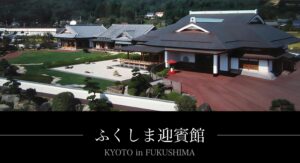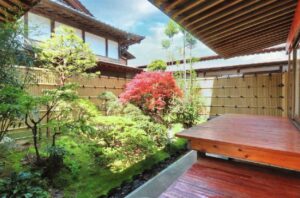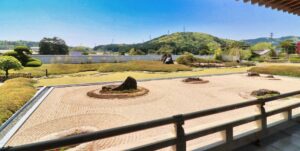
Go Beyond Towers and Yields – Invest in a Story That Lasts.
Global investors who look at Japan often focus on the same things: central Tokyo towers, branded residences, and mainstream hotel flags in the obvious locations.
However, every once in a while, a property appears that does not fit neatly into any standard asset class. It carries the weight of history, the presence of art, and the quiet power to move people emotionally.
The Kyoto in Fukushima – Iwaki Geihinkan estate is exactly such an asset.
This is not “just” a large house or a potential ryokan. It was originally built as the private geihinkan (guesthouse) of a long-established kimono merchant, a place to welcome honoured guests, showcase fine textiles, and host important occasions. Within the same grounds you find an exhibition hall, residential wings, traditional storehouses, a photo studio, and dedicated lodging facilities. In other words, everything a refined Japanese host might need already exists on one carefully composed estate.
Today, the main building also houses a museum dedicated to the works of world-renowned calligrapher Shoko Kanazawa, adding contemporary artistic energy to an already powerful setting. After the 2011 Great East Japan Earthquake, the estate was painstakingly restored and has since served as a symbol of cultural resilience in Fukushima.
For an overseas investor, this estate offers something very rare: the opportunity to own a cultural-asset-class property at a price far below its true replacement cost, and to reposition it as a boutique hospitality, retreat, or private estate asset for the next generation.

From Kimono Merchant’s Guesthouse to Cultural Sanctuary
The story of the estate begins with a kimono merchant who wanted something more than a showroom or a shop. He wanted a place that could express the quiet dignity of his craft and his city.
The result was a geihinkan built in the tradition of Kyoto sukiya architecture. Local miyadaiku (shrine and temple carpenters) were commissioned to execute the project. From the structure and timber selection to the interior finishes, each element was handcrafted:
- Delicate tatami rooms that feel like Kyoto tea houses.
- Shoji screens that filter the light into soft, diffused layers.
- Hand-carved ranma transoms that act as both ornament and storytelling device.
- Carefully aligned views of the garden from each main room.
Over time, the estate was expanded to include:
- A dedicated exhibition hall.
- Residential buildings for family and guests.
- Traditional kura storehouses for valuable items.
- A photo studio for formal portraits and events.
- Purpose-built accommodation facilities for overnight stays.
Walking through the grounds today, you can feel that the original intent was not commercial efficiency. It was hospitality as an art form.

The Presence of Shoko Kanazawa
One of the most striking features of Kyoto in Fukushima is the presence of Shoko Kanazawa, a globally recognised calligrapher whose works have been exhibited in major venues in Japan and overseas.
The main building incorporates a museum space dedicated to her work. Bold, dynamic calligraphy pieces hang against the quiet background of sukiya interiors. The contrast is powerful: contemporary energy inside a deeply traditional architectural shell.
For an investor or operator, this has several implications.
- The estate already has a recognisable cultural “anchor” in place.
- It can be positioned as an art-driven hospitality or retreat destination.
- Collaborations with artists, galleries, and cultural institutions become natural extensions of the current concept.
This is not a blank canvas that needs a story; it is an existing story that can be refined and amplified.
An Asset That Cannot Truly Be Rebuilt
In financial terms, one of the most compelling aspects of the property is the gap between its current asking price and its realistic replacement cost.
The current owner estimates that reconstructing an equivalent estate today – the land size, buildings, garden, stonework, and level of craftsmanship – would require at least JPY 2 billion in construction costs alone. Even then, that estimate assumes that the same materials and skills could still be sourced.
In reality, many of the original elements are now extremely difficult, or simply impossible, to reproduce:
- Large, high-quality timber suitable for traditional joinery.
- Skilled miyadaiku carpenters with experience in shrine and temple work.
- Artisans capable of producing the same level of interior detail, doors, fittings, and ranma carvings.
For this reason, the true value of the property is not only monetary. It is irreplaceability.
To own this estate is to hold what can reasonably be called a Japanese cultural-asset-class property. It is also, in a very real sense, a visible proof of stewardship: an asset that can be handed down as part of a family or institutional legacy, not just a financial portfolio.

What You Actually Get: The Physical Estate
For investors who appreciate the story but also need clarity, the physical overview is as follows.
Property Overview
- Property name
Kyoto in Fukushima – Iwaki Geihinkan (Guesthouse) - Original purpose
Private geihinkan (guesthouse) of a historic kimono retailer, with exhibition, residential, storage, studio, and lodging functions integrated within one estate - Location
71 Negishi, Tono-machi, Iwaki-shi, Fukushima Prefecture
Approximately 20 minutes by car (about 12.4 km) from JR Joban Line “Yumoto” Station - Asking price
JPY 400,000,000 (approximately USD 2,670,000 at JPY 150 / USD, including consumption tax) - Land
Registered land area: approximately 9,408.16 m²
Overall grounds including gardens and parking: approximately 11,000 m²
Land category: residential, mixed-use land, and wild land (as per registration)
City planning: outside urban planning area
Road: fronts a municipal road; no private road burden - Buildings and facilities on site
- Main guesthouse (Geihinkan) in Kyoto sukiya style
- Exhibition hall and museum space for Shoko Kanazawa’s works
- Residential buildings (single-storey and two-storey wooden houses)
- Traditional kura storehouses and a large main warehouse
- Photo studio facility
- Dedicated accommodation units for overnight guests
- Extensive Japanese garden with lanterns, ponds, stonework, and walkways
- On-site parking for visitors and guests
- Total built floor area
Approximately 2,166.43 m² (combined) - Construction and craftsmanship
Kyoto sukiya architecture carried out by local miyadaiku shrine and temple carpenters, with high-grade timber, interior finishes, custom fittings, and carved ranma transoms throughout - Current use
Kanazawa Shoko Calligraphy Museum and managed guesthouse / cultural facility - Legal title
Freehold (full ownership)

*traditional kura storehouse
How Could an Overseas Investor Use This Estate?
Because Kyoto in Fukushima is already a complete compound rather than a single building, it lends itself to several possible operating concepts. A few realistic directions include:
- Boutique ryokan or cultural retreat
The main guesthouse and annexes can be converted into a limited number of very spacious suites, each with a different view of the garden. Programming could include calligraphy workshops, tea ceremonies, local cuisine, and seasonal cultural events. This would appeal strongly to high-income inbound travellers who are seeking “deep Japan” rather than generic tourism. - Destination wedding and events venue
The garden, main hall, and photo studio together form a very strong platform for weddings, anniversaries, and corporate events. The existing museum and cultural story provide a unique brand identity that is difficult for other venues to copy. - Corporate and family-office retreat base
For corporations or family offices that require private, secure venues for offsites, board meetings, and client hospitality, the estate can function as a confidential retreat. The presence of multiple buildings makes it easy to separate guest areas, staff quarters, and back-of-house functions. - Private estate and legacy asset
For an ultra-high-net-worth family or a foundation, the property can be maintained as a private estate with occasional curated events. In this scenario, the financial logic is combined with the desire to preserve and transmit a tangible cultural asset to future generations.
In all of these cases, the emotional power of the estate is part of the business model. Guests are not only paying for a room or an event space. They are paying for a feeling that cannot easily be reproduced elsewhere.

*grand reception room
Why This Matters Now
Japan is entering a period in which inbound tourism, yen valuation, and domestic demographics are reshaping the country’s real estate landscape. Certain assets are becoming . Others are quietly becoming more important as symbols and sanctuaries.
Kyoto in Fukushima belongs to the second group.
It offers:
- A very large, beautifully crafted estate at a fraction of its replacement cost.
- An existing cultural and artistic narrative centred on a world-renowned calligrapher.
- Flexible building stock and land that can support multiple operating concepts.
- The intangible but very real value of being a cultural steward, not just a landlord.
For the right overseas investor, this property is an opportunity to combine return, differentiation, and meaning in a single asset.
If you would like a detailed information package on Kyoto in Fukushima – including floor plans, additional photos, and scenario-based business models for hospitality and retreat concepts – please feel free to contact me directly. I will be happy to provide more data and discuss how this estate could fit into your broader Japan investment strategy.
If you are a family office, private investor, or boutique hospitality operator looking for a truly differentiated asset in Japan, I would be pleased to discuss this opportunity in more detail.
For a full information package on Kyoto in Fukushima – Iwaki Geihinkan (photos, floor plans, and draft business scenarios), please feel free to contact us directly:

Connect with Us for Exclusive Listings & Investment Insights
- LINE – Direct inquiries in Japan
- WhatsApp – For global investors & clients abroad
- Instagram – Market snapshots, listings & updates
- YouTube – In-depth property videos & expert analysis
📱 Scan below to connect instantly.



About the book
Amazon.com Link

#JapanRealEstate
#CulturalAsset
#KyotoinFukushima
#Fukushima
#HospitalityInvestment
#LuxuryRyokan
#AlternativeInvestments
#FamilyOffice
#ImpactInvestment
#InboundTourism
